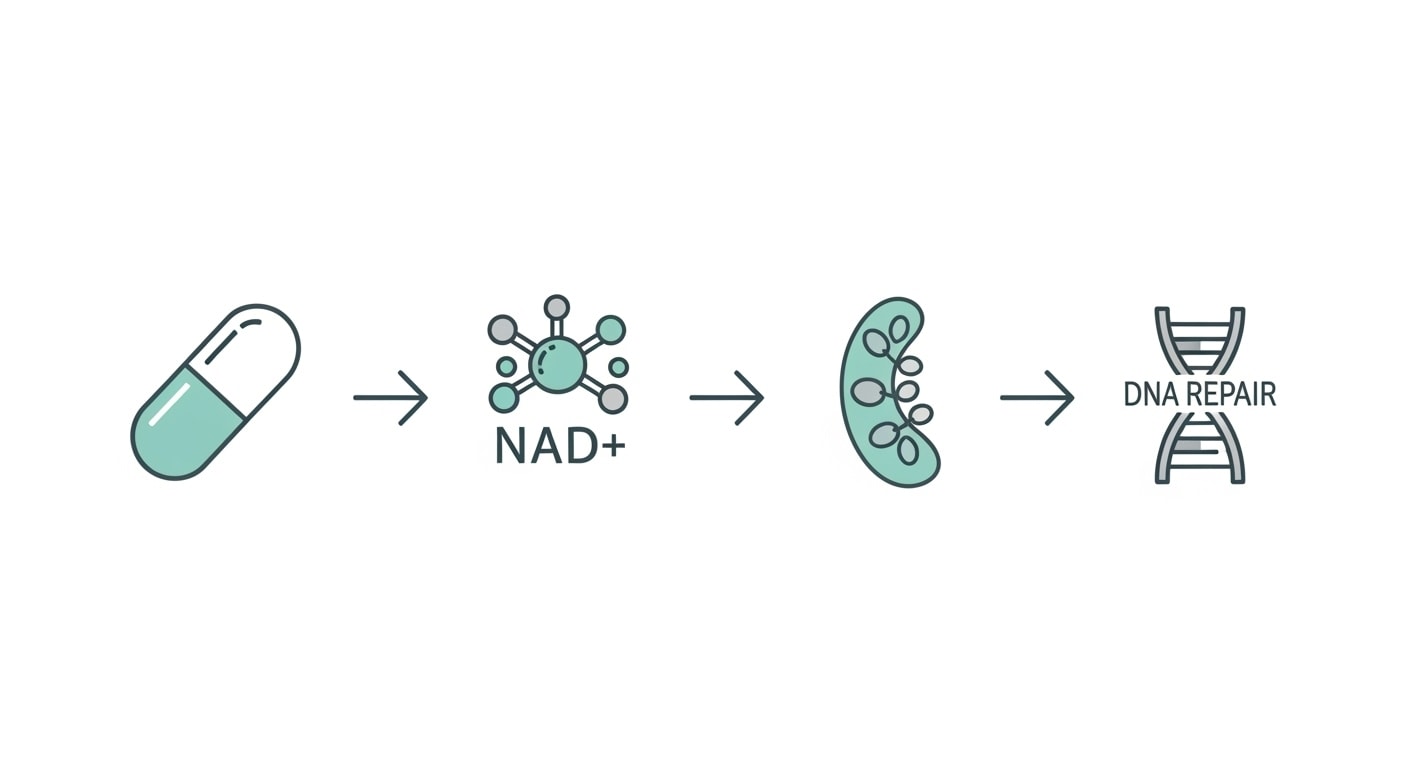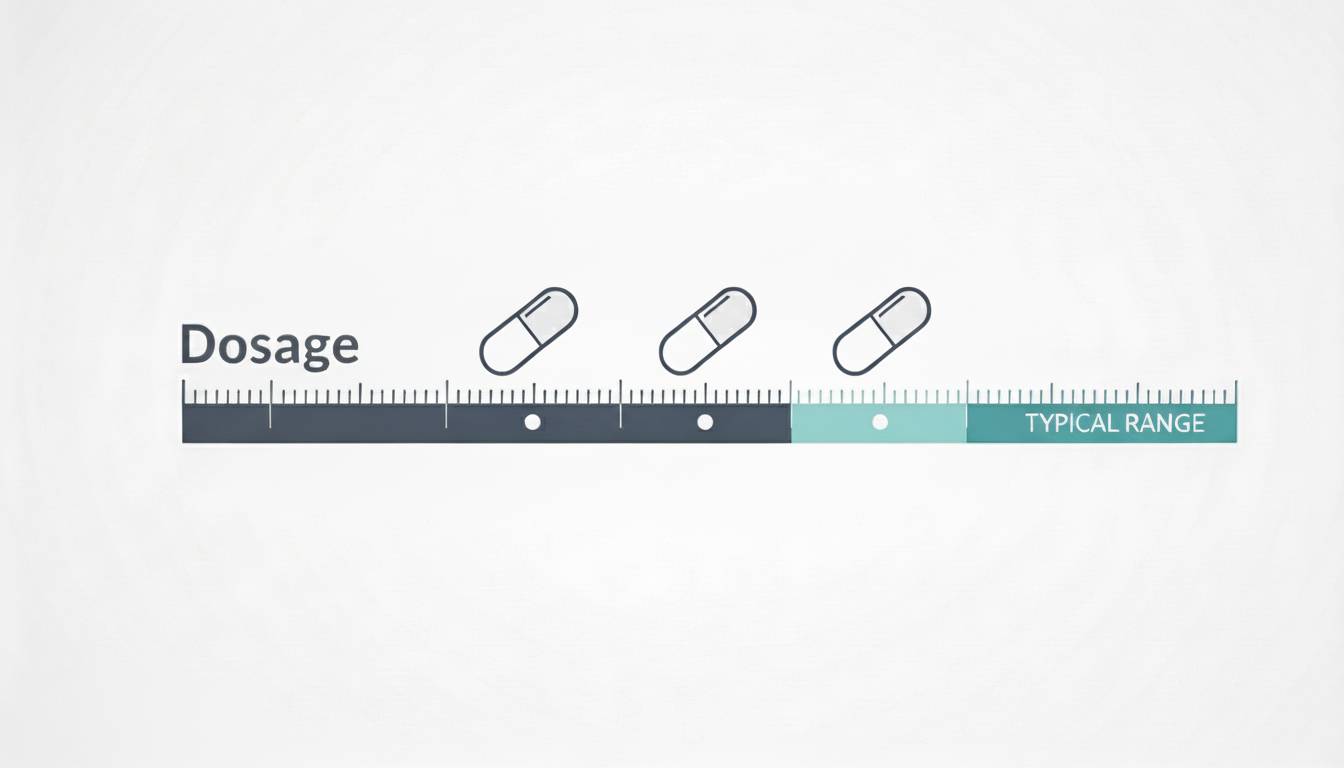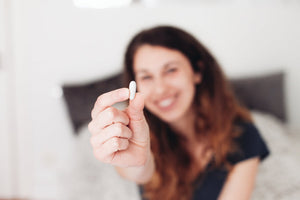The best dose of NMN depends on what you are targeting, but usually 250 - 500 mg/day works for most health benefits. Higher doses are not always better and taking NMN in the afternoon might be more effective!
NMN has become a popular supplement for those interested in healthy aging and vitality. But what is a good dose of NMN, and when is the best time to take it?
This comprehensive guide answers those questions with science-backed insights, including findings from human clinical research that inform the dosage and safety recommendations discussed here. We’ll cover recommended NMN dosage ranges for different individuals, the optimal timing and way to take NMN, and how to personalize your regimen.
Researchers are still uncovering NMN’s benefits, with early studies highlighting the promising benefits of NMN supplementation. Initial research suggests potential benefits for healthy aging, and metabolic health. We’ll also discuss safety, side effects, and common FAQs about NMN. By the end, you’ll understand how to use NMN supplements effectively and safely to support your healthspan. Let’s dive in!
What Is NMN And How Does It Slow Aging?
NMN is a direct precursor to NAD+ (nicotinamide adenine dinucleotide). NAD+ is a coenzyme that your body needs for energy production, DNA repair, gene expression, and other vital processes. This energy production occurs at the cellular level, making NAD+ essential for cellular energy production.
NAD+ levels naturally decline with age, which is linked to fatigue, metabolic issues, and other age-related changes. By taking NMN, we aim to replenish NAD+ and thereby support cellular health and potentially slow aspects of aging.
NMN is a molecule naturally produced in our bodies and found in small amounts in certain foods. However, we can’t get enough of it from food without taking NMN supplements. For instance, NMN rich foods like broccoli only have about 13 mg of NMN for every 100g of broccoli.
Researchers are still uncovering NMN’s benefits, but early studies suggest it might improve insulin sensitivity, heart function, and reduce age-related fatigue. NMN supplementation may also support metabolic health and contribute to better overall human health.
However, finding the right dose is important. More is not always better, and individual needs vary. Next, we’ll look at how much NMN is typically recommended.
Understanding NAD+ And Healthy Aging
NAD+ (nicotinamide adenine dinucleotide) is a vital coenzyme present in every living cell, acting as a cornerstone for energy metabolism and cellular health. It plays a central role in converting the food we eat into usable cellular energy, powering essential processes like DNA repair, gene expression, and the regulation of our body’s internal clock.

As we age, our natural NAD+ levels steadily decline. This drop is linked to a range of age-related health challenges, including reduced energy, slower cellular repair, and increased risk for conditions like diabetes, cardiovascular disease, and neurodegenerative disorders. Maintaining robust NAD+ levels is therefore crucial for supporting overall health and healthy aging.
This is where nicotinamide mononucleotide (NMN) supplementation comes into play. By providing the body with NMN—a direct precursor to NAD+—we can help replenish these declining levels. Research suggests that boosting NAD+ through NMN supplementation may promote better energy metabolism, support cellular resilience, and contribute to a longer, healthier life. For anyone interested in optimizing their healthspan and energy levels, understanding and supporting NAD+ is a key step.
What Is A Normal Dose Of NMN: Recommended NMN Dosage
Finding the right NMN dosage is crucial, as individual needs can influence the most effective amount. NMN dosages should be tailored to each person, and determining the right NMN dosage is important for maximizing benefits and minimizing risks.
Here are some key guidelines on dosing:
- Start low (250 mg/day): If you are new to NMN, begin with a lower dose of 250 mg per day (a quarter of a gram) regardless of age. This conservative starting dose lets you gauge your body’s response and tolerance. Many human trials have used 250 mg as a starting amount and observed health benefits. Gradually increase to higher doses as needed, based on your health goals and response.
- Typical range: For ongoing use, 250–500 mg daily is sufficient for most people. A moderate dose of 500-1000 mg is often effective, especially for healthy middle aged adults seeking to support NAD+ levels, mood, and physical function. Those with more pronounced age-related NAD+ decline may benefit from a higher dose.
- Upper limit (1000 - 2000 mg): Doses as high as 2,000 mg have been studied and shown to be safe in humans. A high dose, such as 900 mg per day, is commonly studied and supported by clinical trial data for increasing NAD+ levels and supporting anti-aging effects. However, exceeding ~1,000–1,200 mg is generally not recommended, as there is likely a point of diminishing returns. One – one study on physical performance found that 1,200 mg didn’t provide an added benefit over 600 mg for aerobic capacity.
In clinical studies and clinical trials, NMN doses are often compared to a placebo group, and physiological measurements such as heart rate and blood pressure are monitored to assess safety and efficacy.
Taking NMN daily (nmn daily) is important for maintaining consistent NAD+ levels and optimizing the benefits of NMN supplementation. Harvard Professor David Sinclair, a leading expert in aging research, has publicly shared his own NMN dosing regimen, often recommending a daily dose in the higher range for anti-aging support.
The benefits of NMN supplementation are supported by both human and animal studies, with clinical trials showing improvements in metabolism, energy, and aging support for various health goals. This is especially relevant for healthy middle aged adults, who can start with lower doses and adjust as needed.
However, more research, particularly large-scale human clinical trials, is needed to confirm the long-term safety and efficacy of NMN supplementation. The optimal dosage and ideal dose depend on individual health goals, and the question "NMN should I take?" is best answered by considering these factors and consulting with a healthcare professional.
NMN Dose For Different Conditions In Human Studies
The dose of NMN largely depends on what you are trying to target. For instance, if you are trying to target systolic blood pressure, about 800 mg/day should work. However, for targeting diastolic blood pressure, you may see effects only at very high doses of up to 2,000 mg/day.
To make it more convenient for you, we have compiled all the information in an easy-to-read table that summarizes all of NMN's dose-dependent clinical trial data.
|
Disease / Condition (Population) |
NMN Dose |
Frequency |
Duration |
Study Design |
Main Outcome(s) |
Source |
|---|---|---|---|---|---|---|
|
Prediabetes / insulin resistance (postmenopausal women with overweight/obesity) |
250 mg |
Once daily (oral) |
10 weeks |
Randomized, placebo-controlled clinical trial |
↑ Muscle insulin sensitivity and insulin signaling vs placebo; metabolomic remodeling in skeletal muscle; improved glucose metabolism. |
(Science) |
|
Age-related decline: sleep/fatigue & function (older adults ≥65 y) |
250 mg |
Once daily (oral); timing arm AM vs PM |
12 weeks |
Randomized, double-blind, placebo-controlled clinical trial |
PM dosing: ↓ daytime drowsiness and better lower-limb function; overall safety acceptable; enhanced muscle function. |
(PMC) |
|
Age-related decline: mobility & sleep (older adults; community-dwelling) |
250 mg |
Once daily (oral) |
12 weeks |
Double-blind, randomized, placebo-controlled clinical trial |
↑ whole-blood NAD+, maintained walking speed, improved sleep quality vs placebo; no NMN-related AEs; support for muscle function. |
(PubMed) |
|
Vascular health: arterial stiffness (adults; subgroup with ↑ BMI / glucose) |
250 mg |
Once daily (oral) |
~12 weeks (long-term arm) |
Randomized, double-blind, placebo-controlled clinical trial |
Trend to ↓ baPWV overall (NS); significant baPWV reduction in higher-risk subgroup (↑BMI/glucose); improved glucose metabolism in subgroup. |
(Nature) |
|
Exercise performance (no disease) healthy amateur runners |
300 / 600 / 1200 mg |
Once daily (oral) |
6 weeks |
Randomized, double-blind, placebo-controlled, 4 arms clinical trial |
Dose-response: ↑ aerobic capacity (ventilatory threshold) at 600–1200 mg > 300 mg; safe across doses. |
|
|
General health / anti-aging (middle-aged & older adults) |
300 mg (2×150 mg) |
Once daily after breakfast |
60 days |
Multicenter, randomized, double-blind, placebo-controlled clinical trial |
↑ NAD+/NADH in blood cells; signals for walking endurance and QoL; safe. |
(PMC) |
|
Safety ceiling (tolerability in healthy adults) |
1250 mg |
Once daily (oral) |
4 weeks |
Randomized, double-blind, placebo-controlled clinical trial |
Well-tolerated; no serious AEs; labs within normal limits. |
(PMC) |
NMN Dosage By Age

It’s worth noting that even low doses can be effective. Benefits like increased NAD+ levels have been observed at 250–300 mg/day, and many routine users find 500 mg/day to be a good dose of NMN for maintenance. Higher doses up to 1 g may be useful for older individuals or specific goals, but starting small is wise.
In summary, clinical studies and clinical trials have shown that NMN supplementation may offer potential benefits for glucose metabolism, muscle function, and cognitive health, in addition to supporting energy metabolism and healthy aging.
Dosage By Body Weight
Your body mass is another factor. A larger individual might require a bit more NMN to achieve the same cellular concentration as a smaller person. Determining the ideal dose or optimal dosage often involves adjusting for individual body weight, as well as considering factors like age and metabolism.
In all cases, listening to your body’s response is key.
What Is the Best Time to Take NMN?

Timing can influence how well NMN works for you. Although the evidence is very limited, one study found that taking NMN in the afternoon produces the greatest effects.
The general recommendation is to take NMN on an empty stomach, which usually would be before breakfast each day. However, a study showed that people who took NMN in the afternoon demonstrated less drowsiness and improved lower-limb function compared to those who took it in the morning. NMN is a water-soluble compound, so the body can absorb it efficiently regardless of food intake, but timing and whether you take it with a meal may affect absorption for some people. If you experience digestive discomfort, consider taking NMN with a meal to help reduce this issue. Proper timing of NMN supplementation can also help maintain sustained energy throughout the day.
Can You Take NMN On An Empty Stomach?
NMN is water-soluble, so it does not require dietary fat for absorption. This means you can take it on an empty stomach if you prefer. NMN is available in both nmn capsules and powder form; capsules are often considered more convenient and may offer consistent absorption, while powder form can be easily mixed into drinks and is also supported by recent research for effectiveness.
Taking NMN first thing in the morning before breakfast may be convenient for most people. If you are practicing intermittent fasting, a morning NMN capsule with water is unlikely to meaningfully break your fast. It has negligible calories and won’t spike blood sugar. NMN can generally be taken alongside other supplements, but consider timing and possible interactions to optimize absorption and safety, and to let it function properly.
Personalizing Your NMN Dosage
No two people are exactly alike in how they respond to supplements. Several factors can influence your ideal NMN dose and routine, including your genetics.
Before starting or adjusting your NMN dosage, it is important to consult a healthcare professional to ensure the supplement is appropriate for your individual needs and health status. When personalizing NMN intake, be aware of potential safety concerns, such as possible interactions with other supplements or medications, and monitor for any side effects.
How Do Your Genetics Affect NAD+ Metabolism?
Our genes influence how we produce and use NAD+. Variations in genes like NAMPT (involved in the NAD+ salvage pathway) might mean some people naturally convert less NMN to NAD+, or break it down faster.
Choosing A Quality NMN Supplement
If you’re ready to add NMN to your routine, it’s crucial to choose a high-quality supplement. The NMN market has grown, and not all products are equal. Here are some tips:
- Purity Look for a product that is ≥99% pure β-NMN (the active form). Lower purity or poor-quality NMN might contain nicotinamide or other impurities that reduce effectiveness.
- Third-party testing Reputable brands will have third-party lab testing to verify the content and purity of their NMN. This ensures you’re actually getting what the label claims, without contaminants (like heavy metals or solvents).
- Form NMN typically comes in capsules or powder. NMN capsules are convenient, offer precise dosing, and are supported by clinical research for their bioavailability and effectiveness in boosting NAD+ levels. NMN powder, or powder form, allows flexible dosing and can be taken sublingually or mixed into water or smoothies; recent research supports its effectiveness and convenience. When choosing between NMN capsules and powder form, consider your preference for dosing, convenience, and absorption. Also, check compatibility with other supplements you may be taking to ensure safety and optimal absorption. Some companies offer sublingual NMN lozenges or liposomal formulations, claiming better absorption. The research backing these forms is limited – standard oral NMN has been shown to absorb well on its own. So fancy forms aren’t necessary, but you can try them if you prefer.
- Storage and packaging Because NMN can degrade with moisture, it’s often best in airtight, light-resistant containers, possibly with desiccant packs. If a powder is shipped in a simple pouch, be sure to transfer it to a sealed jar after opening. Some top brands sell NMN in amber glass bottles to protect from light.
Final Takeaway: What Is a Good Dose of NMN - How Much NMN Should I Take?
For most adults, a good dose of NMN lies between 250 mg and 1,000 mg per day, taken in the afternoon. Start on the low end and increase gradually after a few weeks if needed, noting how you feel.
Remember that NMN is not a quick stimulant. Its benefits are subtle and accrue over time. By personalizing your dosage to your age, weight, and lifestyle, and sticking with a consistent schedule, you can maximize NMN's benefits.
If you decide to try NMN, focus on quality. Choose trusted products like HealthspanX's NMN500, and avoid cut-rate suppliers with dubious purity. A high-grade NMN supplement together with healthy habits (exercise, diet, sleep) can synergistically contribute to better aging.
Be patient and consistent. Give NMN a fair trial of a few months to assess its impact on your wellness. Here's to your health and longevity!
References
- Alegre, G. F. S., & Pastore, G. M. (2025). Determination of NAD+ precursors nicotinamide mononucleotide (NMN) and nicotinamide riboside (NR) in plant foods: exploring dietary sources. CyTA - Journal of Food, 23(1). https://doi.org/10.1080/19476337.2025.2458753
- Song, Q., Zhou, X., Xu, K., Liu, S., Zhu, X., & Yang, J. (2023). The Safety and Antiaging Effects of Nicotinamide Mononucleotide in Human Clinical Trials: an Update. Advances in nutrition (Bethesda, Md.), 14(6), 1416–1435. https://doi.org/10.1016/j.advnut.2023.08.008
- Liao, B., Zhao, Y., Wang, D., Zhang, X., Hao, X., & Hu, M. (2021). Nicotinamide mononucleotide supplementation enhances aerobic capacity in amateur runners: a randomized, double-blind study. Journal of the International Society of Sports Nutrition, 18(1), 54. https://doi.org/10.1186/s12970-021-00442-4
- Yoshino, M., Yoshino, J., Kayser, B. D., Patti, G. J., Franczyk, M. P., Mills, K. F., Sindelar, M., Pietka, T., Patterson, B. W., Imai, S. I., & Klein, S. (2021). Nicotinamide mononucleotide increases muscle insulin sensitivity in prediabetic women. Science (New York, N.Y.), 372(6547), 1224–1229. https://doi.org/10.1126/science.abe9985
- Kim, M., Seol, J., Sato, T., Fukamizu, Y., Sakurai, T., & Okura, T. (2022). Effect of 12-Week Intake of Nicotinamide Mononucleotide on Sleep Quality, Fatigue, and Physical Performance in Older Japanese Adults: A Randomized, Double-Blind Placebo-Controlled Study. Nutrients, 14(4), 755. https://doi.org/10.3390/nu14040755
-
Morifuji, M., Higashi, S., Ebihara, S., & Nagata, M. (2024). Ingestion of β-nicotinamide mononucleotide increased blood NAD levels, maintained walking speed, and improved sleep quality in older adults in a double-blind randomized, placebo-controlled study. GeroScience, 46(5), 4671–4688. https://doi.org/10.1007/s11357-024-01204-1
-
Katayoshi, T., Uehata, S., Nakashima, N., Nakajo, T., Kitajima, N., Kageyama, M., & Tsuji-Naito, K. (2023). Nicotinamide adenine dinucleotide metabolism and arterial stiffness after long-term nicotinamide mononucleotide supplementation: a randomized, double-blind, placebo-controlled trial. Scientific reports, 13(1), 2786. https://doi.org/10.1038/s41598-023-29787-3
-
Liao, B., Zhao, Y., Wang, D., Zhang, X., Hao, X., & Hu, M. (2021). Nicotinamide mononucleotide supplementation enhances aerobic capacity in amateur runners: a randomized, double-blind study. Journal of the International Society of Sports Nutrition, 18(1), 54. https://doi.org/10.1186/s12970-021-00442-4
-
Huang H. (2022). A Multicentre, Randomised, Double Blind, Parallel Design, Placebo Controlled Study to Evaluate the Efficacy and Safety of Uthever (NMN Supplement), an Orally Administered Supplementation in Middle Aged and Older Adults. Frontiers in aging, 3, 851698. https://doi.org/10.3389/fragi.2022.851698
-
Fukamizu, Y., Uchida, Y., Shigekawa, A., Sato, T., Kosaka, H., & Sakurai, T. (2022). Safety evaluation of β-nicotinamide mononucleotide oral administration in healthy adult men and women. Scientific reports, 12(1), 14442. https://doi.org/10.1038/s41598-022-18272-y
-
Xie, N., Zhang, L., Gao, W., Huang, C., Huber, P. E., Zhou, X., Li, C., Shen, G., & Zou, B. (2020). NAD+ metabolism: pathophysiologic mechanisms and therapeutic potential. Signal transduction and targeted therapy, 5(1), 227. https://doi.org/10.1038/s41392-020-00311-7
-
Pencina, K. M., Valderrabano, R., Wipper, B., Orkaby, A. R., Reid, K. F., Storer, T., Lin, A. P., Merugumala, S., Wilson, L., Latham, N., Ghattas-Puylara, C., Ozimek, N. E., Cheng, M., Bhargava, A., Memish-Beleva, Y., Lawney, B., Lavu, S., Swain, P. M., Apte, R. S., Sinclair, D. A., … Bhasin, S. (2023). Nicotinamide Adenine Dinucleotide Augmentation in Overweight or Obese Middle-Aged and Older Adults: A Physiologic Study. The Journal of clinical endocrinology and metabolism, 108(8), 1968–1980. https://doi.org/10.1210/clinem/dgad027
-
Poljšak, B., Kovač, V., Špalj, S., & Milisav, I. (2023). The Central Role of the NAD+ Molecule in the Development of Aging and the Prevention of Chronic Age-Related Diseases: Strategies for NAD+ Modulation. International journal of molecular sciences, 24(3), 2959. https://doi.org/10.3390/ijms24032959







